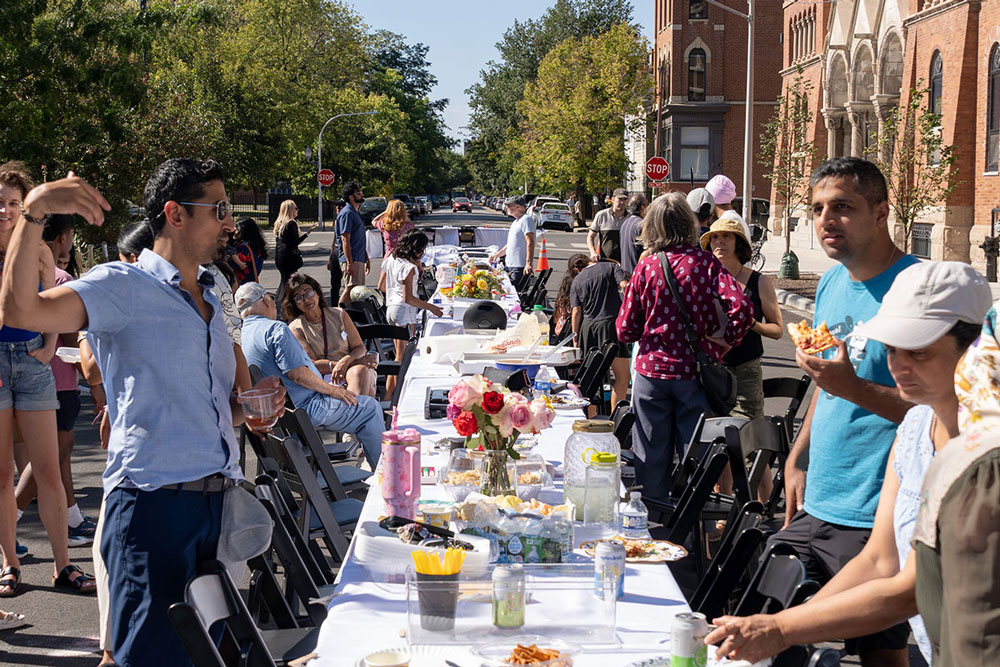
The phrase “community engagement” is everywhere these days. Nonprofits and others aim to employ community engagement practices to ensure input from constituents on everything from grant advising to neighborhood housing to political campaigns.
Nonetheless, it’s no secret that community members in the United States are often not in the driver’s seat when setting nonprofit or public sector priorities. Far too often, those directly affected by decisions are not consulted at all. Using community engagement tools and resources in a well-planned and meaningful way can have a real and lasting impact on communities, decision-making processes, and individual and family wellbeing. But the benefits of community engagement only occur when it is structured in a way that changes power relationships.
What Is Community Engagement?
While there is no single definition of community engagement, I define it as a process by which the people most impacted on a given issue can decide how a program or policy is envisioned, implemented, and/or addressed. It’s mutual decision-making that directly involves the people and community (or the nonprofit) being targeted or talked about rather than having a removed group make decisions on their behalf.
The benefits of community engagement only occur when it is structured in a way that changes power relationships.Prospera Partners, the consulting company I lead, focuses on social impact and systems change through better community engagement. I’ve seen how putting the community first can have real, equitable impact. But despite the ubiquitous use of the phrase “community engagement,” decades of behavior by a nonprofit sector shaped by the nonprofit industrial complex and problematic philanthropy means that those controlling the money often remain the ones expected to provide the solutions.
Changing the status quo requires a fundamental willingness to challenge the relations of power that are implicit in these common top-down practices. As Ellen Shepard, founder of Community Allies, a Chicago-based consulting firm with whom I have partnered, emphasizes, “By empowering communities in decision-making, we not only end up with better solutions; we also disrupt the power structures that have kept inequitable conditions in place.”
How does this work? Here are some key aspects of sound community engagement:
- Gather input that gets to the root cause of problems that can lead to bigger solutions with longer lasting change
- Connect community members to the work and decisions
- Create transparency to provide the opportunity for “buy-in” on projects, decisions, and community development
- Grow stakeholder engagement by expanding the circle of engagement to incorporate more volunteers, more donors, more meeting attendees, and so on
- Improve evaluation outcomes by learning directly from stakeholders, partners, and potential partners
- Develop a more equitable process for input and evaluation (such as by inviting a large group of people to participate rather than a small number of people for a roundtable discussion)
Creating real solutions for the community, with the community, is a strategic process—when done right, it can have a real, lasting impact.
Centering the Community
Too frequently, “community conversations” center on having a speaker…who has the stage, rather than tapping into the power of residents themselves.Hosting and facilitating thoughtful, inclusive conversations can allow community members to clearly define a problem and then envision meaningful solutions. For example, addressing the national housing crisis is a concern and immediate need in many cities across the country right now. Community members experiencing housing insecurity or who have dealt with rising rents and the inability to purchase homes—or are currently unsheltered—are critical to these conversations and can provide key information that informs long-lasting solutions.
While many cities and nonprofits host sessions labeled “community engagement,” it’s worth questioning whether those hosting conversations invite the community in or talk with the same power holders and practitioners over and over. Inviting a much wider range of community members into an inclusive space to participate in these conversations can be a game changer.
Conversations should focus on providing supportive spaces to allow community members as much voice and opportunity as possible to share. Community conversations are ineffective if they are filled with speakers and not focused on the community’s voice. Too frequently, “community conversations” center on having a speaker, often someone with power, who has the stage, rather than tapping into the power of residents themselves.
Two Case Studies
How does community engagement work? In practice, it can be used for many purposes, including supporting communities and developing strategic plans. Here, I focus on two case study examples: the first focuses on tapping into an underappreciated community asset (a city’s creative youth), and the second illustrates how to conduct a community-centered program evaluation.
First, in Newark, NJ, at a community convening to discuss ways to grow the local economy of a multicultural neighborhood, the hosts were committed to a creative and inclusive community engagement process. The goal was to ensure that youth could contribute to the vision of what the neighborhood means to them and how it can better serve them. Young students doodled creative pictures of friendly storefronts and a bodega where they could purchase local food, smoothies, and healthy snacks, but that also welcomed them to hang out in a fun cafe after school. The youth voice in those conversations inspired the neighborhood’s adults and social service providers to launch a community garden and small farmers’ market. Students volunteered and were involved in the planning and designing of the garden and market, where they could hang out and eat healthy food.
The second example comes from Santa Fe, NM, where community engagement was used to develop a more meaningful evaluation process that was accountable to the surrounding community. Homewise, a regional organization whose mission is to help create successful homeowners and strengthen New Mexico neighborhoods, gathered observations from program participants in a home-buying program. Instead of surveys or focus groups, Homewise invested in a process that facilitated conversations open to those who had used the program and those who had yet to use the program but qualified. These conversations allowed for evaluation of the program while also serving to market the program to more potential participants.
The conversations allowed the organization to better understand that a key piece of improving the program was not in tweaking any processes within the offering itself but rather that the program needed more strategic marketing. People did not understand every facet of what was being offered. The community engagement process allowed everyone to see that the best investment for change was on the front end in messaging and marketing, not in changing the program itself.
Sign up for our free newsletters
Subscribe to NPQ's newsletters to have our top stories delivered directly to your inbox.
By signing up, you agree to our privacy policy and terms of use, and to receive messages from NPQ and our partners.
Organizing Community Engagement in Your Community
So, how can nonprofits do community engagement better? Here are some tips:
- Identify your community
Who are you serving? Why do you want to engage with them? What languages will need to be represented? Who are unlikely or potential partners you’d like to have in the conversation? When thinking about partners, don’t forget to invite government officials to participate alongside community members.
- Break down power dynamics
Create a welcoming space with round tables so people can talk regardless of their backgrounds. (But avoid the boring model of a host expert asking people questions.) Hosts can even wander around the space as they introduce themselves instead of talking at the “head of the room” to make the power dynamic more fluid. Encourage participants to sit next to folks they don’t know or would like to know.
- Use community agreements
Establish some ground rules for how to be in community together and ways to engage. These are often things like practicing active listening, turning off cell phones, and honoring confidentiality. These agreements can be posted around the room, on a projection screen or on the tables, but always ask the participants to add to the agreements if they feel the need to, and to consent to the agreements with a simple yes or a thumbs up.
- Choose the right community space(s)
Community centers, churches, and libraries with large meeting rooms are all great, accessible places to convene your community. Choose venues with natural light and familiarity (not hotel conference rooms) to help community members feel welcome and comfortable. Offer food, drinks, and childcare services or a children’s activity corner. Make sure there is enough parking (which might mean paying for it) and that the site is also located on a public transportation route. Offer virtual meeting spaces to include those who can’t attend in person.
- Ensure messaging is clear
Centering community means just that—putting community first and honoring and valuing their time, input, and support.Explain that you want to learn from your community and engage with them. Be clear about the time commitment and what you are asking of their participation. For instance, do you need a few volunteers to help be hosts at tables to keep conversations flowing? Do you need help with the food and drink setup? Do you need volunteers to help with childcare or a children’s activity corner? Share that their input is valuable and that their time spent in the process is respected.
- Offer incentives to participate
Investing in community engagement is key. Value people’s time and input with stipends and gift cards. Further incentivize participation with bus passes, meals, and giveaways to help make your community-centered conversations more accessible.
- Be accountable
Create feedback loops to keep your community involved in conversations and updated on your process. Posting meeting notes and feedback on your website and providing time for further comments and feedback is one great way to stay in touch with your community and remain accountable to them.
- Don’t assume you know all the answers
Your community will provide you with insights that might not have been considered. They might even have more questions for you to address. That’s a good thing! The community can help you identify blind spots or move your organization out of its comfort zone.
- Hire facilitators
They will hold the space for you, and you, as the organization host, can fully participate in conversations. Before beginning, decide when it is best to hire professional facilitators. No facilitation team can hold the identities of all races and genders but strive to have diversity represented with a facilitation team and partners in the work—and bring in those with other lived and work experience to complement the team. Professional facilitators will design and create a welcoming space and help the group adhere to the agenda. Excellent facilitators will allow for an emergent process that allows the organization’s staff and leadership to participate. If you’re an organizational leader, when you participate, be mindful of being the “expert in the room” that participants look to for answers or guidance. Let the community lead.
- Stay in touch
Create channels to provide consistent updates and highlights from your community-centered process. Keep them engaged and updated regularly, and invest in developing trusting and strong relationships.
Centering community means just that—putting community first and honoring and valuing their time, input, and support. As the examples from New Jersey and New Mexico illustrate, with a thoughtful process, community engagement can help groups develop creative responses to many challenging community issues.











